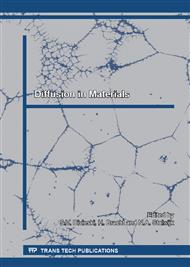p.173
p.178
p.186
p.190
p.196
p.202
p.210
p.219
p.225
Depletion of Manganese in the Surface Layers of Fe-Mn-Si Shape Memory Alloys by Annealing
Abstract:
X-ray diffraction (XRD) and electron microprobe microanalysis (EPMA) were used for characterizing the structure and composition of surface layers formed on austenitic Fe-Mn-Si shape memory alloys under vacuum. The XRD results demonstrated that during annealing, face centered cubic austenite is transformed to hexagonal close packed martensite on the alloy surface. The EMPA results revealed that manganese in the surface layer was depleted during annealing. Further, this analysis determined that the thickness of the surface layer of the alloy annealed at 1173 K for 1 h was approximately 20 μm and that value is consistent with the depth detected by XRD. The compositional changes of the surface layers such as manganese depletion by annealing were discussed based on the ternary Fe-Mn-Si phase diagram. Although the formation of body centered cubic ferrite is detrimental to shape memory alloys, the amount of manganese was also observed to change during processing and strongly influence the stability of the shape memory alloys.
Info:
Periodical:
Pages:
196-201
Citation:
Online since:
May 2015
Price:
Сopyright:
© 2015 Trans Tech Publications Ltd. All Rights Reserved
Share:
Citation:


